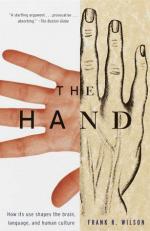
|
Prologue and Dawn
• Hands and arms come to life before we wake. Wilson plans to show the physical roots of human creative work.
• He shows the anthropological and evolutionary views, bio mechanical and physiological characteristics, and neuro behavioral and developmental perspectives.
• Wilson argues that the human brain is permanently immature but that people are born resourceful and with experience become skillful and thoughtful.
• "Lucy" lived 3.2 millions years ago. Her hand is not ape-like, but her brain is the size of a chimpanzee brain.
• That the brain and musculoskeletal systems evolve by changing structure and function over time distinguishes a tool-using hominid.
• Bipedal gait and upper arm changes and the driving force of the hominid's brain also distinguish tool-using hominids.
• Wilson claims, though, that the brain is the last organ to evolve after the hominids become tool users.
• Brain and behavior evolves from primitive tool use like rock-pounding and...
|
This section contains 2,474 words (approx. 9 pages at 300 words per page) |

|




